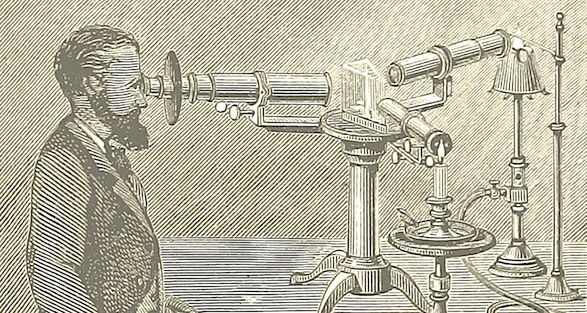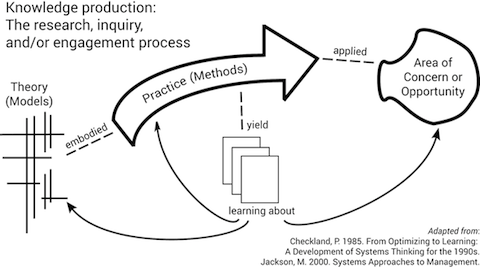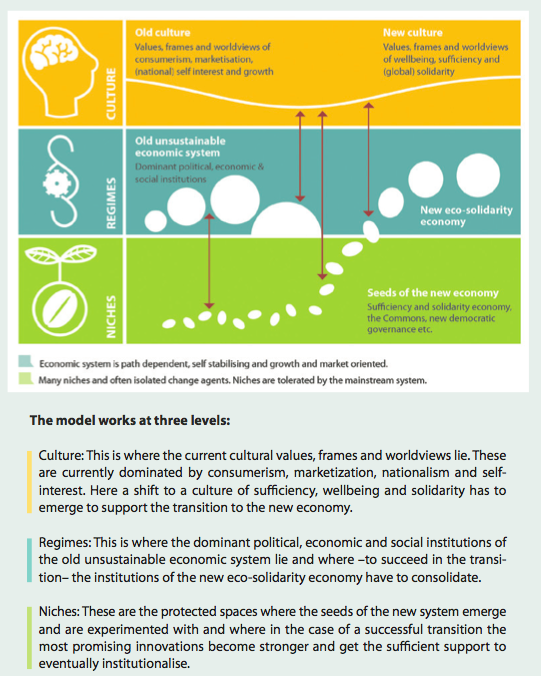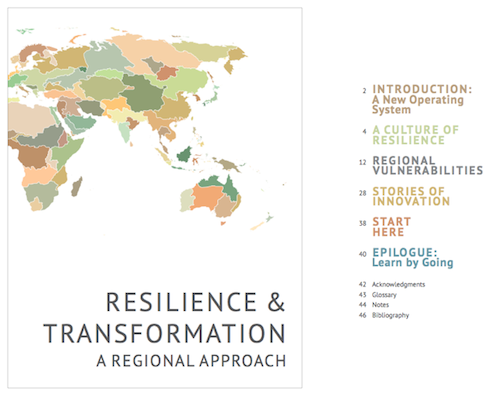
I’ve posted an article on Medium:
Jill Lepore’s popular essay in The New Yorker, “The Disruption Machine: What the Gospel of Innovation Gets Wrong,” requires some annotation.
Image: spectroscope, The British Library, on flickr

I’ve posted an article on Medium:
Jill Lepore’s popular essay in The New Yorker, “The Disruption Machine: What the Gospel of Innovation Gets Wrong,” requires some annotation.
Image: spectroscope, The British Library, on flickr

The flux of everyday life — both physical and mental — surrounds and subsumes us. Amidst this flux we find ourselves immersed in life’s situations.
Some situations are satisfying, others less so. These less-satisfying situations are perceived as areas of concern or opportunity.
Perceiving an area of concern or opportunity, and developing a theory for learning about or effecting change in this focus area is the beginning of the process of knowledge production.
This process might be take the form of research, inquiry, and/or engagement; and this process — based on theories, embodied in practices, and applied to an area of concern or opportunity — yields learning about all three: the theories, practices, and focus area.
That’s my basic re-telling of Peter Checkland’s “learning for action” narrative.
The simple model above is adapted from Checkland’s 1985 paper, “From Optimizing to Learning: A Development of Systems Thinking for the 1990s.” It’s also given prominence at the beginning of Michael Jackson’s 2000 book, Systems Approaches to Management — and used to good effect, for it communicates much in its simplicity.
Whereas Checkland used the model to describe a shift in practice or methods, from hard to soft, from “optimizing to learning,” Jackson took a broader view. He used it to describe shifts in the the nature of science itself: from knowledge production in-service-to-theory to knowledge production in-service-to-action.
These days, such approaches are often called transdisciplinarity or action research.
From the introduction to 2008′s The SAGE Handbook of Action Research: Participative Inquiry and Practice:
[T]he primary purpose of action research is not to produce academic theories based on action; nor is it to produce theories about action; nor is it to produce theoretical or empirical knowledge that can be applied in action; it is to liberate the human body, mind and spirit in the search for a better, freer world.
>> See more models in the gallery.
In recent media about climate change, a couple of voices and emotions linger with me.
Here’s one, from a commenter on the June 3rd Diane Rehm show about new US policies on carbon dioxide emissions: “It’s frustrating that there is no answer on how much CO2 reduction is needed to halt global warming.”
We don’t hear the actual voice, because Diane reads out the commenter’s written words. Still, the raw sentiment comes through loud and clear.
How would you respond to this person?
One might focus on “how much.” Tell the story of 350 (parts per million of CO2 in the atmosphere) and that current levels are already at 401.28 (June 8th Scripps reading from Mauna Loa).
Or one might focus on the word “halt” — a problematic word for describing a process that will continue for millennia.
My sense, though, is that the word to start with is “frustration.” This emotion needs to be acknowledged and engaged.
Easy to say from the sidelines or in hindsight perhaps. Diane’s guest, Frances Beinecke of the Natural Resources Defense Council, responded (~36:20), “I don’t think the number is as important as the trend.”
In one sense, this is a strong response. Talking about trends puts the emphasis on action. And in fact the trend has already turned for US energy-related CO2 emissions.
Still, while talk of numbers, processes, and trends might work for some people, we’ve got to learn to better speak to people’s emotions as well.
Which brings me to the other lingering voice I mentioned, the voice of atmospheric scientist Katharine Hayhoe, dealing with her own emotions on the TV series Years of Living Dangerously: “I naively thought I would study climate science until we fixed the problem, and then I’d go back to astrophysics. That was a long time ago.”
If you’d like to check out the recent Resilience 2014 conference, this video embedded above offers an inside look at the interdisciplinary conversations.
Social anthropologist Melissa Leach, economist Luca Alinovi, and ecologist Brian Walker each begin by describing the influence of resilience thinking on their work. Leach focuses on the relationship between resilience and the STEPS Centre pathways approach. Alinovi relates his efforts at bringing a resilience perspective into the Food and Agriculture Organization. Brian Walker thinks back forty years to recall his reaction to Buzz Holling’s landmark 1973 paper.
These introductions begin at 16:00 of this 1:45:00-long video and are followed by questions from the PhD students gathered for the evening’s “master class.”
Here are a couple of segments that caught my attention.
Brian Walker, responding to the question: How do you understand and elicit the mental models of participants about the ecosystems they are involved with? (~50:00)
In the studies that we are doing with groups, where we try to elicit from them what their mental model is of the system they are working in, we begin by asking: What is it that you value in the system? What does it produce? Or what does it have that you particularly value?
Then we use, deliberately, the word identity. What gives that system its identity and makes it somewhat different to some other system? And that combination of trying to figure out a limited set of values — because you can’t have a long one — and what is the identity of that system, that is a first way in.
And another way that we then go beyond that — I don’t know if you’ve come across the notion of state-and-transition modeling. You ask: What is the current state of the system now? Tell us what it is now, in terms of those values you really value. And then: What other states could it be in? Could it be in a better state? Could it be in worse states? And then you start asking: What would cause it to go from one state to another?
Out of that, you start to get the dynamics, the mental model that people have. [For example] you would need to have a long drought before it could go from this state to that. Or if you had a big fire, you could get it from there to there. So you ask them what is it that would move it from this state to this other state you said it could be in.
You’ve got to elicit from them the dynamics and the processes that are involved. And gradually what comes out of this is an iterative process of developing a mental model of the system.
Melissa Leach, responding to the question: What if good policy design fails to result in good policy implementation? (1:09:20)
The way that I think about policy … has not been to make a big distinction between design and implementation. That’s the standard way that policy processes are thought about: there’s design, and implementation, and then evaluation, and then sometimes you get a feedback.
Whereas I think if we look at the way policy happens in the real world, it’s a much more iterative process, where feedbacks between what’s happening on the ground and what’s happening in design are much more constant, much more interactive. And often policy is de facto made, not by people sitting in offices, writing policy documents, but by what’s happening on the ground.
I find the literature on street-level bureaucrats and field-level bureaucrats very interesting, because this actually shows the agency of agricultural extension workers or urban sustainability planners, or front-line medical workers in actually de facto making policy, in a way that is sometimes much more responsive to local realities — and can sometimes feed back up into higher level decisions.
So I think one of the things one needs to do to make things implementable is to start with implementation, start with the practices. And then ask how good practices, which are sometimes a bit deviant from the norm, can be made more normal, can be institutionalized. And how you can get those channels of knowledge and practice working up from the grassroots, from the day-to-day practice, which is very engaged with local knowledge and realities on the ground — how those areas of wisdom and discretion can feed back up into shaping implementable, designable policies.
That would be one response.

It’s good to see people who are engaged in social change activities making use of models from complexity. Case in point: the 2013 “Civil Society in Transition” (pdf) report from Smart CSOs, a group that nurtures systems thinking and promotes cultural transformation among a network of mostly European civil society organizations. Their core model (cc-enabled) is above.
Civil society work is hampered, they write, by a set of “old cherished stories [that] are broken.” Controversial stuff, and worth a look. Among their “broken” stories:
The focus is instead, and as depicted above, on systemic shifts to: a cultural narrative of wellbeing, sufficiency, and solidarity; the institutions that would support such a new culture; and niche-scale initiatives that form the seeds of such a transition.
An academic introduction to this type of approach is in the 2009 paper by Jan Rotmans and Derk Loorbach, “Complexity and Transition Management.”
“I did not write this book in order to save the Earth,” begins Dale Jamieson in his new book, Reason in a Dark Time: Why the Struggle Against Climate Change Failed — and What It Means for Our Future. “My goal is to make you think.”
Seeing the book reminded me of this 2009 interview, in which Dale certainly made us all think.
That year, I published a couple of Dale’s articles on the ethics of climate change and of geoengineering. Months later, I joined the Portland Center for Public Humanities for this interview moderated by Avram Hiller, along with co-interviewer Ramona Ilea. (Originally posted as: “What do philosophers bring to the climate discussion?”)

With the triennial Resilience 2014 conference next month, I was looking back at this post I wrote after the 2011 conference. Fair to say, I think, that these statements still hold: resilience is increasingly discussed yet often narrowly understood.
As we wrote in the title of the publication above, the resilience of social and ecological systems is best understood in a dynamic relationship with transformation. No resilience without transformation. Yet, as Katrina Brown recently noted, resilience is “often interpreted as means of staying the same, of resisting change.”
Here’s my post of April 2011:
The idea of resilience, increasingly discussed, remains narrowly understood.
Increasingly discussed: Google shows a sharp uptick in news references since the beginning of the year.
Narrowly understood: That’s the finding of a media content analysis presented at the Resilience 2011 conference. From the abstract (pdf) by Anne Leitch and Erin Bohensky:
We use content analysis of Australian news media articles from 2005-2010 to examine resilience concepts associated with natural disasters. Articles analyzed included those that mentioned resilience in conjunction with disasters such as bushfires, floods or drought, and discuss dealing with, recovering from, or preparing for such events.
Preliminary analysis suggests that the public construction of the resilience concept is diverse but narrow with fewer dimensions than the theoretical basis of the concept used by the Resilience Alliance though some similarities are evident. Common themes associated with resilience in the news media include the ability to return to a ‘new normal’, community cohesion, community preparedness, experience and learning.
Here is a recent – and memorable – media reference I saw, from the Washington Post:
“Think of resilience in terms of the old Timex commercial,” said Jack Hayes, director of the National Earthquake Hazard Reduction Program. “It can take a licking and keep on ticking.”
This take-a-licking-keep-on-ticking quality of resilience, is described by Resilience Alliance scientists as “persistence” – and as one of three attributes of resilience thinking. The other two are adaptability and transformability.
From a 2010 paper by Carl Folke and coauthors, “Resilience Thinking: Integrating Resilience, Adaptability and Transformability“:
In a nutshell, resilience thinking focuses on three aspects of social–ecological systems (SES): resilience as persistence, adaptability and transformability. … Adaptability is a part of resilience. Adaptability is the capacity of a SES to adjust its responses to changing external drivers and internal processes and thereby allow for development within the current stability domain, along the current trajectory.
Transformability is the capacity to create new stability domains for development, a new stability landscape, and cross thresholds into a new development trajectory. Deliberate transformation requires resilience thinking, first in assessing the relative merits of the current versus alternative, potentially more favorable stability domains, and second in fostering resilience of the new development trajectory, the new basin of attraction.
Illustrating the distinction between adaptation and transformation (from a 2006 paper: “A Handful of Heuristics and Some Propositions for Understanding Resilience in Social‐Ecological Systems”):
A change from sheep to goat production in rangelands in the face of changes in vegetation and markets is an example of adaptation in a livestock production system.
However, replacing ranching with wildlife‐based ecotourism and hunting and involving joint enterprises by combining properties to operate at larger scales, as in the central United States or in southern Africa, is an example of transformation.
“Creativity,” defined landscape architect Ian McHarg, is “the employment of energy and matter to raise matter and energy to higher levels of order.”
This creativity “always shows the tendency to move from a greater to a lesser randomness, from simplicity to complexity.”
Creative fitting, therefore, is “the ability to find of all environments the most fit, and to adapt that environment and oneself.”
The “synoptic attribute,” or metric, by which one might “determine whether any system in fact accomplishes creative fitting” is “health.”
Health is “the capability of recovery from insult,” and a healthy person is “one who not only solves problems but also seeks them.”
These are the key elements of McHarg’s theory of creative fitting, from 1976 lecture recordings, published in 2006 as The Lost Tapes and in 2007 as Conversations with Students.
He summed up:
So, that is the theory. It is simple minded, but then I am simple minded. I am not a scientist. It has to be simple, or I would not have discovered it. It has to be simple, or I would not be able to use it. That is it. There is something called creativity. We can identify creative fitting. Creative fitting is absolutely required for any system, be it a social system or a natural system. The accomplishment of creative fitting will be revealed in health.
In this video from the 1997 ESRI users conference, ESRI president Jack Dangermond introduced McHarg as the person that “invented many of the concepts of environmental conservation and the notions of using a methodology to do rational planning, considering environmental factors.”
McHarg takes the stage, full of poetry, at 2:30. His talk is in two video parts:
I collect design principles. Some are identified as design principles, others not; but they are unmistakable anyway. These are not the “what we stand for” or “why we do what we do” principles. These are the “how” principles: high-level guidelines that inform the selection and development of methods or practices, heuristics for effective engagement in the world.
The best ones are intriguing, informative, and also revealing about the perceived design context. In other words, they offer a glimpse into a designer’s conception of the design environment, with its constraints and affordances.
Buzz Holling, for example, summarized in a 2011 talk his lifetime of adaptive ecosystem management experience as a set of guidelines. Then, in software development, there’s the agile manifesto, which to my ears sounds a lot like Holling.
Holling: Much of established theory is severely limited at the time — too simplistic, too static, too uniform in scale and perceived by the originators as too certain. The fixed world of standard environmental protection is rigid and wrong.
Agile Manifesto: Working software over comprehensive documentation. Responding to change over following a plan.
Gar Alperovitz’s principles are for the design of a pluralist commonwealth. Jeff Leitner’s are for the design of design labs. Elinor Ostrom’s well-known principles about sustaining common pool resources are better re-imagined in the active voice.
Then there’s Kevin Kelly, whose so-called laws of god are for “governing the incubation of somethings from nothing.”
Distribute being.
Control from the bottom up.
Cultivate increasing returns.
Grow by chunking.
Maximize the fringes.
Honor your errors.
Pursue no optima; have multiple goals.
Seek persistent disequilibrium.
Change changes itself.
Got any design principles? What are your favorites?
Robin Chase on policies to ensure that autonomous vehicles serve the public good (“Will a World of Driverless Cars Be Heaven or Hell?”):
So policy makers, taxpayers, road warriors, city lovers: Which path forward will we choose? Our future hinges on two things. First, will the cost for autonomous vehicles be high enough that each vehicle will need to be used well? If so, the economic imperative to share the cars will set us down the efficient-use path. Second, will we add a per-mile fee for human-free passenger vehicles? We will need that to temper our insatiable desire to send machines out to do our bidding.
Tom Chatfield on the laws of robotics-type dilemmas that arise (“Automated ethics”):
If my self-driving car is prepared to sacrifice my life in order to save multiple others, this principle should be made clear in advance together with its exact parameters. …
As agency passes out of the hands of individual human beings, in the name of various efficiencies, the losses outside these boxes don’t simply evaporate into non-existence. If our destiny is a new kind of existential insulation – a world in which machine gatekeepers render certain harms impossible and certain goods automatic – this won’t be because we will have triumphed over history and time, but because we will have delegated engagement to something beyond ourselves.